Florida Trail
The Florida Trail is one of eleven National Scenic Trails in the United States. It currently runs 1,000 miles (1,600 km),[1] with 300 miles (480 km) planned, from Big Cypress National Preserve (between Miami and Naples, Florida along the Tamiami Trail) to Fort Pickens at Gulf Islands National Seashore, Pensacola Beach. Also known as the Florida National Scenic Trail (which applies only to its federally certified segments), the Florida Trail provides permanent non-motorized recreation opportunity for hiking and other compatible activities[2] and is within an hour of most Floridians. The Florida National Scenic Trail is designated as a National Scenic Trail by the National Trails System Act of 1968 (Public Law 90-543).[3]
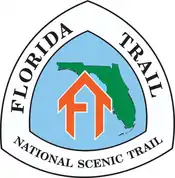
| Florida Trail | |
|---|---|
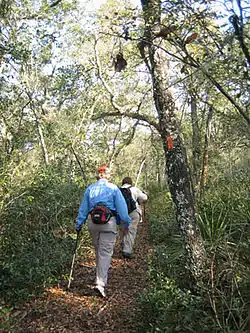 Hiking the Florida Trail through the Ocala National Forest on the Western Corridor | |
| Length | 1300 mi (2092 km) |
| Location | Florida |
| Established | October 29, 1966 |
| Designation | National Scenic Trail |
| Trailheads | Big Cypress National Preserve, Fort Pickens at Gulf Islands National Seashore, Pensacola Beach |
| Use | Hiking allowed throughout, other uses allowed in certain sections by land manager: non-motorized recreation opportunity for hiking and other compatible activities |
| Hiking details | |
| Trail difficulty | Moderate |
| Season | Year-round, maintained for seasonal use September through April |
| Hazards | Severe weather, alligators, venomous snakes, bears |
With its first blaze marked by members of the Florida Trail Association at Clearwater Lake Recreation Area in the Ocala National Forest, the Florida Trail began on October 29, 1966. The Florida Trail was officially designated as a National Scenic Trail in 1983. The U.S. Forest Service, through the National Forests in Florida program, is the official administrator of the Florida National Scenic Trail (FNST), but trail development, maintenance, and management are a result of volunteers and land managers throughout the state.
History
In the early 1960s, Miami resident Jim Kern headed to North Carolina with his brother for a hike on the Appalachian Trail. Returning to Florida and knowing there was nowhere near his home to go backpacking, he envisioned a 500-mile (800 km) hiking trail across Florida. He founded the Florida Trail Association and encouraged members to join him in the vision of creating a trail across the state. His initial hike, a media event for the Miami Herald, took him from the wilds of Big Cypress to Highlands Hammock State Park near Sebring. By October 1966, Kern had spoken with the managers of the Ocala National Forest and received permission to start blazing a hiking trail. After a feasibility study, the trail was officially designated in 1983 as a National Scenic Trail. The Florida Trail has been underway as a volunteer-driven construction project ever since. Like many other National Scenic Trails, the Florida Trail has been built in disconnected segments, created in a corridor where public land (or easements granted by private individuals) is available to route the trail.
FNST partners
Land managers
- The Florida National Scenic Trail is managed by more than 25 different agencies and private partners.[4] Partnerships, memorandums of understanding, and certification agreements between these agencies, land managers and owners, and the USDA Forest Service create unique management opportunities to celebrate Florida’s natural, cultural, and historic resources via the FNST.
- Land managers include the National Park Service, South Florida Water Management District, St. Johns River WMD, Suwannee River WMD, Northwest Florida WMD, US Army Corps of Engineers, US Air Force, Florida Fish and Wildlife Conservation Commission, Forever Florida, Florida Forest Service, Seminole County, US Forest Service, FDEP-Division of Recreation & Parks, Florida Department of Military Affairs, Plum Creek Timber Company, City of Blountstown, Florida Department of Transportation, Nokuse Plantation, Santa Rosa Island Authority, Escambia County, the University of West Florida, and US Fish & Wildlife Service.[5]
Stewardship partners
The Florida Trail Association is a non-profit partner of the FNST, administering a volunteer program to construct, maintain, and garner support for the Trail. Dedicated volunteers monitor the condition of the Trail and associated facilities.
The FNST Coalition
The FNST Coalition was established in 2010 by the Forest Supervisor of the National Forests in Florida with the goal of engaging a broader group of partners to manage the Trail and serve recreationists. The Coalition is composed primarily of agency, district, or company leaders who own or manage the land through which the FNST passes. The FNST Coalition’s engagement of a diverse group of stakeholders will continue to make the Trail a high quality, recreational resource. The Florida National Scenic Trail 5-Year Strategic Plan was released in 2012, setting goals for trail completion, standards, partnerships, and FNST promotion. Coalition members participate in bi-annual meetings to address emerging issues and to exchange resources such as expertise, funding, and information.[6]
FNST route
The 1,000-mile (1,600 km) Florida National Scenic Trail consists of four main geographic regions:[7]
Regions
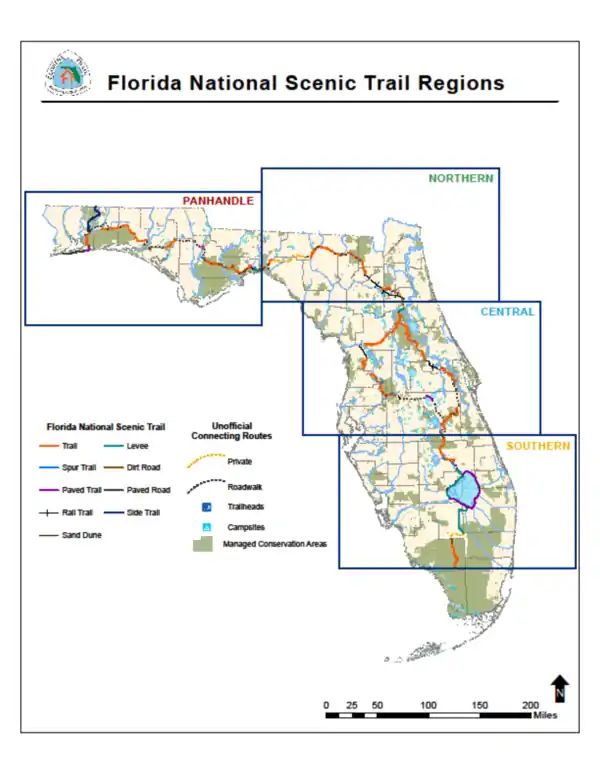
- The Southern Region consists of:
- Big Cypress National Preserve
- Miami Canal Levee L1, L2, L3
- Lake Okeechobee & Okeechobee North
- Kissimmee River Lands
- Avon Park Air Force Range
- KICCO Wildlife Management Area
- The Central Region consists of:
- Three Lakes Wildlife Management Area
- Forever Florida
- Herky Huffman/Bull Creek Wildlife Management Area
- Tosohatchee Wildlife Management Area
- Seminole Ranch Conservation Area
- C.H. Bronson State Forest
- Mills Creek Woodlands
- Little Big Econ State Forest & Flagler Trail
- Cross Seminole Trail
- Lower Wekiva River Preserve State Park
- Seminole State Forest
- Ocala National Forest
- The Cross Florida Greenway
- Withlacoochee State Forest
- Green Swamp Wild Management Area
- The Northern Region consists of:
- Rice Creek Conservation Area
- Etoniah Creek State Forest & Palatka Lake Butler
- Plum Creek
- Osceola National Forest & Olustee Battlefield
- Fall Creek
- Forest Service Tracts & Stephen Foster Culture Center State Park
- Swift Creek Conservation Area & Camp Branch Conservation Area
- Suwannee River Farms Management Areas
- Holton Creek Conservation Area & Lower Alapaha Conservation Area
- Suwannee River State Park
- Twin Rivers State Forest
- Aucilla River
- The Panhandle Region consists of:
- St. Marks National Wildlife Refuge
- Tallahassee-St. Marks Historic Railroad State Trail
- Apalachicola National Forest
- Blountstown Greenway & SR20
- Upper Chipola Water Management Area
- Econfina Creek Water Management Area
- Pine Log State Forest
- Nokuse Plantation & Choctawhatchee River Water Management Area]]
- Eglin Air Force Base
- Yellow River Water Management Area
- Gulf Islands (Gulf Islands National Seashore, Santa Rosa County, Navarre Beach, Pensacola Beach)
Additional trails
Flora and fauna
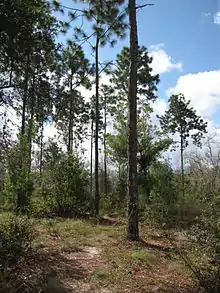
Florida is home to a unique range of environments not seen anywhere else in the world; this means that there are amazing wildlife and nature viewing opportunities on the FNST. The Trail crosses both urban and remote wilderness areas, and traverses a variety of semi-tropical ecosystems. From swamps to forests to prairies to springs, there are endless habitat exploration opportunities. Additionally, the FNST is the only National Scenic Trail to include a beach walk.
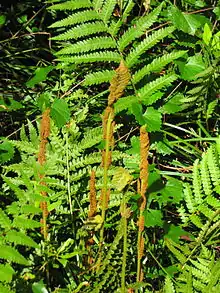
- Types of Plant Life by Region
- Southern Region: Swamplands and pine flatwoods are common in the Southern Region of the FNST. The Trail passes through cypress swamp, pine, prairies of cabbage palm, saw palmetto, sawgrass, marsh, oak hammocks, and scrub.
- Central Region: Palmetto prairies, pine flatwoods, ranch land, cypress sloughs, freshwater marshes, scrub, and oak hammocks are found in the Central Region.
- Northern Region: Longleaf pine and wiregrass are common features in the Northern Region of the Trail. Additionally, users can find flatwoods, pine plantations, hardwoods, cypress, and oak hammocks.
- Panhandle Region: Users can encounter salt marsh, hardwood hammocks, coastal pine flatwoods, pine savannas, wild ground orchids, pitcher plants, titi swamp, hydrangea, magnolia, liverworts, and dune grasses in the Panhandle Region.
- Types of Wildlife by Region
- Southern Region: Common wildlife in the Southern Region includes panthers, Florida black bears, cattle, alligators, and a wide variety of birds.
- Central Region: Sandhill cranes, wood storks, cattle, white-tailed deer, feral hogs, wild turkey, bobwhite quail, river otters, alligators, Red Widow spider, Florida pine snake, black bears, and gopher tortoises are all found in the Central Region.
- Northern Region: Common wildlife includes red-cockaded woodpeckers, gopher tortoises, black bears, eastern cottontail rabbits, wild turkeys, deer, red-tailed hawks, gators, and Gulf sturgeon.
- Panhandle Region: Waterfowl, bald eagles, ospreys, otters, alligators, deer, black bears, warblers, sea turtles, and piping plovers can be spotted in the Panhandle Region.
- Cautionary
- There are six species of venomous snake in Florida: Eastern Diamondback Rattlesnake, Southern Copperhead, Cottonmouth/Water Moccasin, Timber Rattlesnake, Dusky Pigmy Rattlesnake, and Coral Snake. Eastern Diamondback Rattlesnakes, Dusky Pigmy Rattlesnakes, and Coral Snakes are found across the entire state of Florida. The Southern Copperhead is typically only found in the Panhandle of Florida, whereas the Timber Rattlesnake is found in northeastern and north central parts of the state, with few sightings in the panhandle. There are two species of Cottonmouth/ Water Moccasin found in Florida: the Florida Cottonmouth and the Eastern Cottonmouth. The Florida Cottonmouth is found throughout the state, while the Eastern Cottonmouth is found only in the western edge of the panhandle of Florida.[8]

FNST resources
References
- "Florida National Scenic Trail". USDA Forest Service. Retrieved 1/10/2014. Check date values in:
|access-date=(help) - "What is the Florida Trail (FNST)?". Florida Trail Association. 2013-07-10. Retrieved 2016-01-06.
- Act of Oct 2, 1968; PL. 90-543, 82 Stat. 919, 16 U.S.C. §§ 124l-51.
- USFS Partner page
- "FNST Land Manager List". USDA Forest Service- Florida National Scenic Trail. USDA Forest Service. Retrieved 22 January 2015.
- "Working Together". USDA Forest Service- Florida National Scenic Trail. USDA Forest Service. Retrieved 22 January 2015.
- "Florida National Scenic Trail". USDA Forest Service. Retrieved 1/10/2014. Check date values in:
|access-date=(help) - "List of Venomous Florida Snakes :: Florida Museum of Natural History". www.floridamuseum.ufl.edu. Retrieved 2020-03-20.
External links
- Florida National Scenic Trail: US Forest Service page
- Florida Trail Association
- USDA Forest Service: National Forests in Florida
- Florida Greenways & Trails Guide
- American Trails: Florida
- GORP.com: Florida National Scenic Trail
- Trailjournals.com: Read what it's like to hike the Florida Trail
- iNaturalist Project for the Suwannee River area of the Florida Trail

